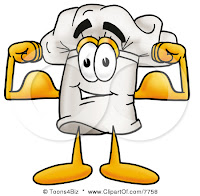We did emulsion sauces this week at school which meant manual labour. Ok it wasn't that bad but I am going to try and become ambidextrous just because of this lesson. An emulsion is a mixture of two liquids that don't like each other and come together to make one. We made a hot emulsion; hollandaise and a cold emulsion sauce; mayonnaise. Both require you to whisk egg yolks and fat until you get a thick creamy delicious sauce.
For the mayonnaise we whisked a teaspoon of french mustard, a teaspoon of white vinegar with two egg yolks together until pale. We then added about 230mL of olive oil in a fine drizzle while continuously whisking. If you add too much oil at once or over whisk it splits and you end up with gooey oily mess. The way to fix this is add a teaspoonful of boiling water to your mixture and whisk or if its really split start again but whisking an egg yolk in a separate bowl and adding your split mixture to your single egg yolk like you wee doing with the oil. To avoid over mixing your mayonnaise don't whisk it when you have stopped adding your oil and only whisk when adding your oil. Have I confused you yet?
For the hollandaise there was a little more whisking involved. You start by making a reduction of 30mL white wine, 30mL vinegar, 30mL water, 1 tbsp of finely shopped onion and a few peppercorns crushed. Reduce this until the alcohol is cooked away and it has reduced. It should taste bitter when you taste it (nasty!). You then strain your reduction and add your 3 egg yolks to this. Whisk over simmering water until it is so fluffy it can hold its own. This is where you need to make sure NOT to scramble your eggs. Remember that protein sets at 60 degrees so you can not let your eggs get to above 60 degrees. A trick we were taught was that if the bottom of the bowl is too hot for your hand then its too hot for the eggs so take it off the heat for a bit and keep whisking. You are in control of the heat! When the eggs get to the creamy extra fluffy stage you can start adding your clarified butter in a fine drizzle while whisking. We added about 250mL of clarified butter to this mixture and it turned out deliciously rich.
(Health tip: don't keep homemade hollandaise for more than 20min. Because it has to be kept at blood temperature it is most dangerous temp for bacteria to grow in (the danger zone: 5-60 degrees Celsius). Just keep it in the fridge you say? your sauce will go solid because of the butter in it. Just don't want my readers to attempt this delicious sauce and then think they can keep it for the next day or something like that because its a lot of work for only 20 min)
Whats clarified butter you ask? It's also known as ghee. It is where the milk solids are removed from the butter so you can heat it at a higher temperature without burning it. Here is a link where some chef does it on youtube. I did it slightly different in class and melted the butter using a double boiler and the milk solids sunk to the bottom and I carefully tipped the clear section into a jug without getting the white bit. Everyone does it differently and I couldn't fine a clip with someone doing it my way. Do what ever works for you :)
Show:
| This is my deconstructed prawn cocktail with mayonnaise and a derivative of mayonnaise; cocktail sauce. |
| Toffee flowers that come on top of a croquembouche for a wedding at work. YUM :) |
